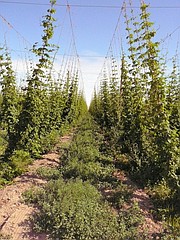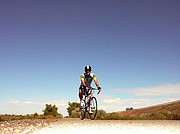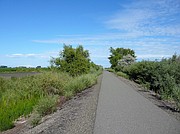Wine Country touring
By JERRY HITCHCOCK
Staff Writer
Ask someone the first thing that comes to mind when they hear Yakima Valley, and the answers you’re sure to receive will center around fruit, agriculture, and maybe vineyards and wine.
Ask them again about exercise opportunities, and aside from tubing or boating on the Yakima River, they may come up empty.
But yes, I’m here to tell you the valley has nice paths with trailheads that offers visitors and residents alike the chance to get out, stretch their legs and enjoy the plentiful central Washington sunshine and natural beauty.
The Lower Yakima Valley Pathway stretches 14 miles from a trailhead near the town center in Prosser to a trailhead in the center of Sunnyside. Along the way, the trail meanders past fields of the core crops in the valley: Apples, grapes and the newest addition, hops.
Hops production has exploded in the region, now accounting for 80-90 percent of the nation’s output, depending on what research and source you want to stand by. But make no mistake, the quick-growing vine has a near stranglehold on the valley, with fields of the crop popping up seemingly everywhere. Why so many hops? Well, all those craft beers aren’t made from thin air — they gotta get those ingredients from somewhere and the need for hops has swollen exponentially in the last 10 or so years.
Hops, or hop cones, are the female flowers of the perennial herbaceous hop species Humulus lupulus, and are utilized in beer brewing for their antibacterial effect which promotes the activity of brewer’s yeast. In addition, hops aid in balancing the natural sweetness of malt with bitterness and add stability to beer.
The region reaps large harvests due to its rich, volcanic ash soil. Add in easy access to water (via the Yakima River) and the region is perfect to cultivating all those tasty things we love to consume.
- • •
The wife and I (along with the pup, Journey) spent some time last summer at Wine Country RV Resort, which is only a few blocks from the pathway in Prosser. One morning, I easily made my way over to the path, and headed north. About a mile later, the path crosses Wine Country Road and stays for the majority of its length, with Interstate 82 up above. But don’t worry — there’s enough to look at so you won’t notice the faint highway noise too often.
As you ride, you’ll get great views of Mount Hood to the west and Mount Rainier to the northwest. You’ll also no doubt go past any number of crops that will soon show up on your table or in your glass.
I came upon the hops first (big surprise) on both side of the road, and stopped to grab a few pictures. Unfortunately the hop cones had not yet formed, but you could almost see the plants growing if you stood still for a minute. Next I came upon an orchard of Gala apples, and just south of Grandview there were vineyards, with the fruit starting to form, ready for a hot summer to hastens its ripening.
By the time you leave Grandview, the valley shows itself fully, with hills on both sides of the trail stretching beyond focus. Vineyards roll with the hills and farmworkers scurry about here and there, tending to crops and doing any number of tasks in preparation for one of the many harvests throughout the growing season in the valley.
The trail loses its rural feel when you get into Sunnyside, with the crops making way for strip malls and businesses of all sorts.
On my way back, I passed a few locals, out for a mid-morning jaunt. The sun met my forehead and legs and I found myself reaching for my water bottle more often as I headed south and back into Prosser.
The trail officially ends immediately before a bridge and pathway that cross the Yakima River and take you into downtown Prosser. If you cross the bridge and head south of Seventh Street, you’ll see BG Cycles on the right, if your bike is in need of adjustment or other service. There’s also a large restaurant/public house and a smattering of antique/gift shops downtown.
The great thing about this region is the abundance of paved roads, most with wide shoulders (and virtually no traffic) and many winding through vineyards and leading to wine tasting rooms. You could literally spend a month in the region and ride a new set of roads every day if you so chose.
If you plan on staying to the north, a nice, 10-mile trail lets you traverse the largest city in the region.
The Yakima Greenway connects residents with the outdoors by providing access to the Yakima River, many lakes, parks and nature trails, past and through protected conservation areas and the Yakima Area Arboretum. Thanks to wildlife viewing platforms along the way, it’s possible to spot wildlife including bald eagles.
The pathway follows the river from Yakima south to Union Gap. Another rail-trail project may one day extend the Yakima Greenway’s reach another 10 miles north to Naches.
- • •
Jerry Hitchcock can be reached at 664-8176, Ext. 2017, via email at jhitchcock@cdapress.com, or follow him on Twitter at HitchTheWriter.







